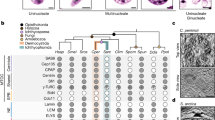Abstract
In a recent paper1, I have described four heterochromatic accessory chromosomes of a very small type in the moss Grimmia Mühlenbeckii Schimp. Further investigations on meiosis in mosses have revealed five accessory chromosomes of the same type in a population of Dicranum majus Turn. found near the State Horticultural Institute in south-west Finland. In their behaviour the accessories resemble in many respects those found in Grimmia. Besides being small, they are heterochromatic and incapable of conjugating with the normal chromosomes though, however, conjugating freely with one another.
This is a preview of subscription content, access via your institution
Access options
Subscribe to this journal
Receive 51 print issues and online access
$199.00 per year
only $3.90 per issue
Buy this article
- Purchase on Springer Link
- Instant access to full article PDF
Prices may be subject to local taxes which are calculated during checkout
Similar content being viewed by others
References
Vaarama, A., Portug. Acta Biol., (A), Goldschmidt Vol., 47 (1949).
Vaarama, A., [Bot. Not., 133 (1950)].
Östergren, G., Hereditas, 33, 263 (1947).
Müntzing, A., Hereditas, 30, 213 (1944).
Darlington, C. D., J. Genet., 39, 351 (1940).
Müntzing, A., Hereditas, 29, 91 (1943)
Author information
Authors and Affiliations
Rights and permissions
About this article
Cite this article
VAARAMA, A. Accessory Isochromosomes in the Moss Dicranum majus. Nature 165, 894–895 (1950). https://doi.org/10.1038/165894a0
Issue Date:
DOI: https://doi.org/10.1038/165894a0
This article is cited by
-
Supernumerary chromosomes in Tradescantia I. Meiotic behavior of three homologous isochromosomes
Genetica (1987)
-
Akzessorische Chromosomen bei Achillea: Struktur, cytologisches Verhalten, zahlenm�ssige Instabilit�t und Entstehung
Chromosoma (1960)
-
Genetics of fragment chromosomes in Trillium grandiflorum
Heredity (1956)
-
Die Entwicklung von Zelle und Kern im Protonema von Funaria hygrometrica Sibth
Planta (1955)
Comments
By submitting a comment you agree to abide by our Terms and Community Guidelines. If you find something abusive or that does not comply with our terms or guidelines please flag it as inappropriate.



